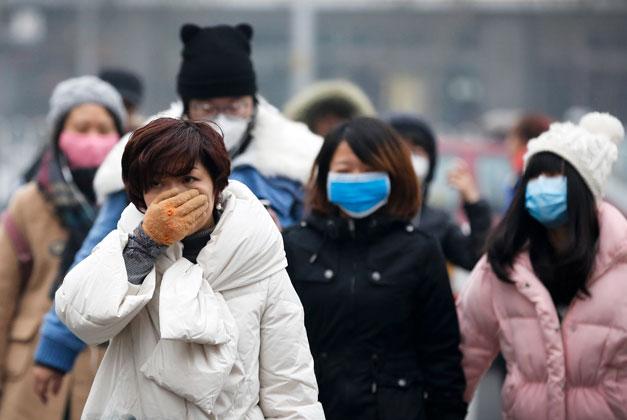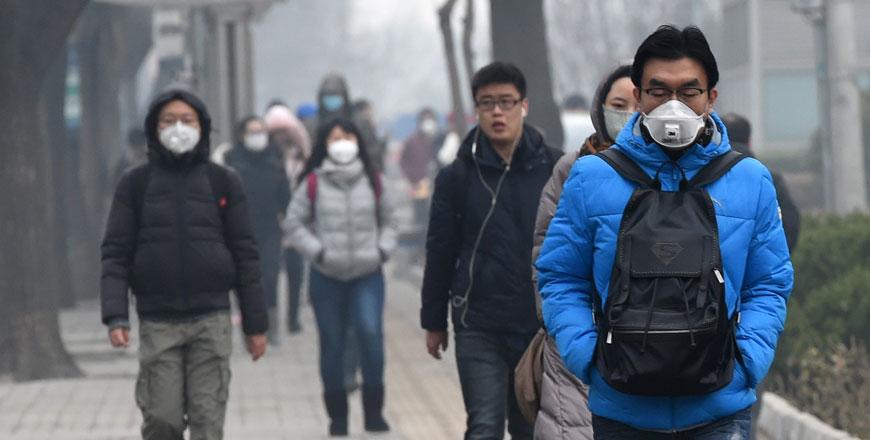You are here
Coughing and unwell, Beijing patients lament smog
By AFP - Dec 09,2015 - Last updated at Dec 09,2015

A woman uses her hand to cover her face from pollutants as people walk along a street on a polluted day in Beijing on Tuesday (AP photo)
BEIJING — Seeking treatment for respiratory illnesses, Beijing hospital-goers complained Wednesday that their conditions were being worsened by toxic smog, now in its third day and which prompted authorities to declare a pollution "red alert".
The capital's 21.5 million residents were besieged by levels of PM2.5 — harmful microscopic particles that penetrate deep into the lungs — over 300 micrograms per cubic metre, according to the US embassy, which issues independent readings.
The World Health Organisation's recommended maximum exposure is 25.
"Because of the smog, I generally tend to wear a mask indoors as well as outside, but today, I don't even dare to go out," said Yu Silong, who has been hospitalised for three days and had to quit his supermarket job to seek treatment.
"Polluted smog didn't cause my asthma, but it greatly aggravates it," he added, sitting on his bed at the Wangfu Hospital in northern Beijing, an antibiotic drip running into his arm.
Liu Yanping, whose husband had just been diagnosed with a benign throat tumour that prevented him from speaking, said: "The past few days, he's been coughing and feeling horrible."
All they could do was "close the windows and doors" of their Beijing housing, she added.
Beijing and much of the country has has been blighted by chronic air pollution for years, and the capital's red alert coincided with global climate change talks in Paris, where China is in the spotlight as the world's biggest polluter.
Most of the country's greenhouse gas emissions come from the burning of coal for electricity and heating — particularly when demand peaks in winter — and is also the main cause of smog, which can include multiple pollutants.
Gao Yongda, the head of the respiratory ward in which Yu was hospitalised, told AFP that PM2.5 penetrates into the respiratory system to cause coughing, sore throat and shortness of breath.
"The number of patients has grown in recent years. Smog is an important factor in the aggravation of diseases," he said.
Long-term damage was more significant, however, as PM2.5 "doesn't necessarily cause visible effects right away", he explained, adding that there would probably be "an explosion of disease cases" in five years' time or later.
'Unfavourable conditions'
Pollution red alerts spread to more Chinese cities, state media reported Wednesday, with officials warning that poor conditions could last until Saturday in some places.
Dingzhou and Xinji, two cities in Hebei province, which surrounds Beijing, followed the capital's lead to issue their first ever red alerts, the state-run China Daily reported, while 27 other cities across northern parts of the country also upgraded their public warning levels Tuesday, it said.
More than 300 million people in the region were affected by the toxic air, it added.
"According to forecasts, from December 8 to 12, the overall conditions for the atmospheric diffusion [of smog] are unfavourable," said the Beijing Environmental Protection Bureau on its official website earlier this week.
The capital issued its first ever red alert for pollution on Monday — the highest in the four-tiered, colour-coded warning system adopted nationally, but lacking in standardisation, with regulations differing from city to city.
It has grounded half of the capital's private vehicles, ordered construction sites and certain factories shut, and recommended school closures, forcing parents to scramble for childcare options.
The chronic haze blanketing northeastern China was so thick earlier this month that, unlike the Great Wall, it could be seen from outer space, according to satellite photographs from NASA.
Related Articles
BEIJING — Half of Beijing's private cars were ordered off the streets Tuesday and many construction sites and schools closed after authoriti
NEW DELHI — New Delhi banned half the Indian capital's private cars from its roads on Monday as the megacity's 20 million people spluttered
SHIJIAZHUANG, China — China's smoggiest city closed schools Wednesday as much of the country suffered its sixth day under an oppressive haze


















